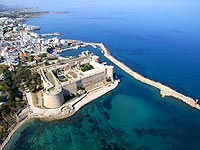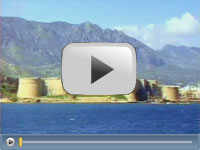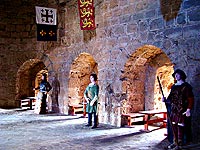
Kyrenia Castle Cyprus
 |
the north cyprus travel guide |
 |
|
Kyrenia Castle
Kyrenia Castle in Northern Cyprus stands at the entrance to the harbour at Kyrenia, guarding this important and strategic North Cyprus port since the 1500s. There has been a settlement at Kyrenia since the 10th century BC, but the first major castle at Kyrenia was constructed by the Romans, and subsequently fortified by the Byzantines. The Byzantine structure of four towers linked by walls was later strengthened and enlarged by the Lusignan family. The current appearance of Kyrenia Castle dates from when the Venetians were "given" the island of Cyprus in 1489. Venetian KyreniaAs soon as the Venetians acquired Cyprus, they were paranoid about losing it to the rapidly expanding Ottoman Empire. With the mainland only miles away, and the Ottomans gaining strength every year, the Venetians set about fortifying Cyprus.
Kyrenia Castle’s walls were greatly enlarged and made thicker to withstand possible artillery attacks, and to resist any siege. The Venetians replaced the simple drawbridge entrance with an elaborate protected gatehouse as seen today, and retained the Byzantine 12th century church of St George the Castle safely within the walls. Kyrenia Castle todayAs you walk into Kyrenia Castle today, you pass through the fortified entrance in the northwest corner of the castle, and on up a sloping ramp that leads to the parade ground in the centre. You’ll pass a green-cloth covered tomb on your way, where an Ottoman admiral is buried. The parade ground itself is lined with guardrooms, stables and living quarters, and more ramps lead to defences on the upper sections of the walls. You can also climb steps that take you to the Lusignan royal apartments and a small chapel. Head down into the depths of Kyrenia Castle and you’ll discover dungeons, storage rooms and the all-important powder magazines, where the gunpowder was stored clean and dry, ready for use.
The battlements of Kyrenia Castle, North CyprusIt’s well worth climbing to the battlements of Kyrenia Castle during your holiday on North Cyprus, and you can even walk around the entire castle walls, with care. The view from the castle across Kyrenia harbour is amazing, just what the defending Venetians needed to check for that dreaded invasion. The irony is, when the Otoman invasion finally came in 1571, the Venetians gave up without a fight.
The Shipwreck Museum in Kyrenia, Northern CyprusKyrenia Castle also houses the Shipwreck Museum, home to one of the most remarkable marine archaeological finds in the world. In 300BC, a trading vessel, laden with millstones and amphorae (large jars) of wine from Kos and Rhodes set sail for Cyprus. The ship was caught in a storm, and was wrecked outside Kyrenia harbour. The remains of the ship sat on the sea bed covered in sand for 2300 years until 1965, when the remains of what was then the oldest recovered ship in the world began to be recovered. The 47ft long hull, made of Aleppo pine covered in lead, is preserved in a specially controlled environment in the Museum, along with wine jars, some utensils used by the crew, and 9000 almonds, which were part of the crew’s rations.
For a great day out in Kyrenia, the castle and harbour area will keep the whole family entertained, excited – and well fed! |
|
North Cyprus quick: holidays | flights | hotels | property | kyrenia | famagusta | photos | map | weather | history | news
All text is copyrighted by Cyprus44. Photographs are copyrighted by their respective photographers.
For more information read our copyright policy, privacy policy and disclaimer.
This web page is served on 18 September 2025 at 6:45:49 AM.
![]()
Cyprus44 in other languages: Nordzypern | Chypre Nord | Severní Kypr | Северный Кипр
partner sites: goNorthCyprus Travel | Pacific Rent-A-Car | Amy Holiday Villas | other partner sites











